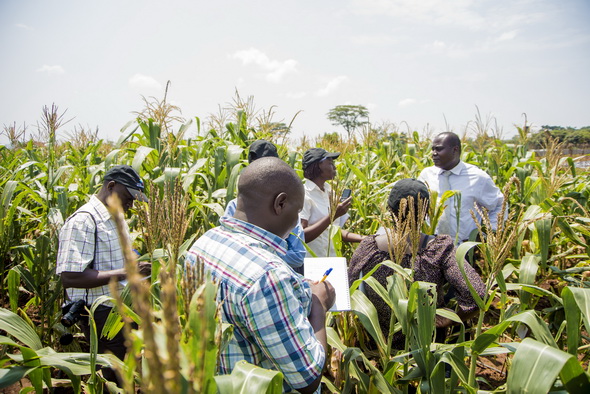CROP BIOTECH UPDATE
---------------------------------------------------------------------------
A weekly summary of world developments in agri-biotech for developing countries, produced by the Global Knowledge Center on Crop Biotechnology, International Service for the Acquisition of Agri-biotech Applications SEAsiaCenter (ISAAA)
---------------------------------------------------------------------------
March 14, 2018
In This Week’s Issue:
News
Africa
• African Seed Companies Encouraged to Invest in Biotechnology
• Ugandan Journalists Vow to Change the Rhetoric against Science
Americas
• Scientists Engineer Crops to Use 25% Less Water; Resist Drought
• Researchers Discover How Weeds Develop Glyphosate Resistance
• Forty Years of Data Quantifies Benefits of Bt Corn Adoption Across Different Crops
Asia and the Pacific
• Report Confirms Ban on GM Crops in South Australia Does Not Deliver Any Benefits to Farmers
• Japan to Finalize GE Labeling Requirements Soon
• Study Quantifies Cost of Delayed GM Canola Adoption in Australia
Europe
• GMOinfo.eu Website is Launched
Research
• Researchers Develop GM Sugarcane with Pyramided Insecticidal Proteins
• Maize Gene Improves Drought Tolerance and Grain Yield in Rice
• RNAi Confers Resistance Against Sugarcane Mosaic Virus
New Breeding Technologies
• CRISPR-Cas9 Found Applicable to Alfalfa
• Scientists Study Seed Germination in Lettuce Using CRISPR
• Chinese Researchers Study Abiotic Stress Tolerance Genes in Rice
• Safer Potatoes Developed Using CRISPR-Cas9
Beyond Crop Biotech
• First-Ever Transgenic Tick to Help Fight Tick-Borne Diseases
Announcements
• 2nd Biotechnology World Symposium
----
NEWS
----
Africa
AFRICAN SEED COMPANIES ENCOURAGED TO INVEST IN BIOTECHNOLOGY
 Seed companies in Africa have been challenged to explore ways of developing their own biotech products to meet the rising needs of food in the continent amid devastating effects of climate change and emerging pests. Addressing more than 450 delegates from 50 countries at the African Seed Trade Association (AFSTA) Annual Congress held on February 26-March 1, 2018 in Cairo, Egypt, the Executive Manager of Biosafety South Africa, Dr. Hennie Groenewald, expressed his concern that Africa has not taken advantage of the benefits accrued from use of biotechnology.
Seed companies in Africa have been challenged to explore ways of developing their own biotech products to meet the rising needs of food in the continent amid devastating effects of climate change and emerging pests. Addressing more than 450 delegates from 50 countries at the African Seed Trade Association (AFSTA) Annual Congress held on February 26-March 1, 2018 in Cairo, Egypt, the Executive Manager of Biosafety South Africa, Dr. Hennie Groenewald, expressed his concern that Africa has not taken advantage of the benefits accrued from use of biotechnology.
On his part, the Deputy Chairman of the Agricultural Research Institute of Egypt, Mohammed Soliman Mohamed, urged the seed companies to ensure breeders continually select correct genotype as a means of unlocking food insecurity in Africa. "This should be followed by excellent crop management practices. For me, that is the work that seed companies must do for the continent's agriculture," Mohamed remarked.
Outgoing AFSTA President Denias Zaranyika said that his association will continuously work to give farmers high performing seeds as it focuses on breeding techniques that significantly improve harvests and address farmers' needs. This will ultimately contribute to the transformation of Africa smallholders from subsistence farming to commercial and smart farm enterprises.
Delegates also discussed how best to manage the devastating fall armyworm that has wreaked havoc in most farms in the continent. AFSTA Secretary General Justin Rakotoarisaona revealed the distressing effect of the pest, worsened by climate change impacts, which has enormously affected seed production in Africa. "AFSTA Congress remains an organized effort for exchange between the major players of private seed sector and to discuss current issues affecting seed production in Africa," Rakotoarisaona said. The Congress was attended by top seed traders and producers from around the world, including representatives of regional and international organizations, namely CropLife International, International Seed Federation, International Seed Testing Association, Asia and Pacific Seed Association, Union for the Protection of New Plant Varieties, and African Intellectual Property Organization.
For more about the congress, download the media release or contact Daniel Aghan at daghan@afsta.org.
UGANDAN JOURNALISTS VOW TO CHANGE THE RHETORIC AGAINST SCIENCE
The Cornell Alliance for Science, in collaboration with Water Efficient Maize for Africa (WEMA) Project, Uganda Biosciences Information Center (UBIC), and other partners conducted a two-day training workshop on agricultural biotechnology for Ugandan journalists from March 9-10, 2018 at the National Crops Resources Research Institute (NaCRRI) in Namulonge, Wakiso district, Uganda.
The workshop brought together representatives of the fourth estate from various media houses in the country. The objective was to provide tips and guidance on how agricultural biotechnology stories can be reported in a manner that is appealing to one's audience using the Water Efficient Maize for Africa (WEMA) Project as a case study.
Speaking at the event, Dr. Godfrey Asea-Director NaCRRI expressed optimism that farmers will soon be allowed to use GM crops currently in field trials in the country. "Once the (biosafety) law is ready, we have a promising product to move to the next episode of deregulation and deployment," noted Dr. Asea while addressing workshop participants during a tour of the WEMA field trial at NaCRRI.
This comes on the backdrop of a protracted political stalemate regarding application of some modern biotechnologies for agricultural development in Uganda. This has resulted in efforts to get products of modern agricultural technologies, such as GM crops, into the hands of farmers stifled due to the absence of a national enabling policy. Uganda's National Biosafety Act passed by Parliament in October 2017 was referred back by President Museveni citing concerns that have been addressed.
The workshop participants deliberated on critical issues associated with science communication. They also brainstormed on a strategic way forward to change the rhetoric against science in the media and facilitate science-based decision making in a time of unprecedented urgency.

For more details, contact ubic.nacrri@gmail.com.
Americas
SCIENTISTS ENGINEER CROPS TO USE 25% LESS WATER; RESIST DROUGHT
Agriculture is the top user of the world's freshwater, and the increasing population puts more pressure on this precious resource. For the first time, scientists from the United States and United Kingdom have improved how a crop uses water by 25 percent without compromising yield by altering the expression of one gene that is found in all plants.
The research is part of the Realizing Increased Photosynthetic Efficiency (RIPE), an international research project led by the University of Illinois. The team led by RIPE Director Stephen Long increased the levels of a photosynthetic protein (PsbS) to conserve water by tricking plants into partially closing their stomata. When stomata are open, carbon dioxide enters the plant to fuel photosynthesis, but water escapes through transpiration. Carbon dioxide concentration in the atmosphere has increased by 25 percent in the past 70 years, allowing plants to amass enough carbon dioxide without fully opening their stomata.
Four factors trigger stomata to open and close: humidity, carbon dioxide levels in the plant, the quality of light, and the quantity of light. This study is the first report of hacking stomatal responses to the quantity of light. PsbS is a key part of a signaling pathway in the plant that relays information about the quantity of light. By increasing PsbS, the signal says there is not enough light energy for the plant to photosynthesize, which triggers the stomata to close since carbon dioxide is not needed to fuel photosynthesis.
For more details, read the article in the Carl R. Woese Institute for Genomic Biology.
RESEARCHERS DISCOVER HOW WEEDS DEVELOP GLYPHOSATE RESISTANCE
Kansas State University (K-State) researchers have discovered the mechanism by which weeds develop resistance to the popular herbicide glyphosate. The research team found how Palmer amaranth and common waterhemp evolved resistance to glyphosate in such a short time. Based on research, they discovered that glyphosate resistance in Palmer amaranth occurred very rapidly.
They found that glyphosate-resistant Palmer amaranth plants carry the glyphosate target gene in hundreds of copies. Mithila Jugulam, a K-State weed scientist and co-author of the PNAS article added, "Even if you applied an amount much higher than the recommended dose of glyphosate, the plants would not be killed."
The chromosome experts on the team looked at these glyphosate-resistant weeds, the glyphosate target gene, along with other genes actually escaped from the chromosomes and formed a separate, self-replicating circular DNA structure. This structure is called extra-chromosomal circular DNA (eccDNA). Each eccDNA has one copy of the gene that produces an enzyme that is the target for glyphosate. Because there are hundreds of eccDNAs in each cell, there is also an abundant amount of enzyme. Therefore, the plant is not affected by glyphosate application and the weed is resistant to the herbicide.
Jugulan said, "Glyphosate has a lot of good characteristics as an herbicide. The recommendations that K-State and many others are promoting is ‘do not abuse glyphosate.' Use the recommended integrated weed management strategies so that we do not lose the option of using glyphosate for the sustainability of our agriculture."
For more, read the K-State Research and Extension News. The full article can be accessed on the website for the Proceedings of the National Academy of Sciences.
FORTY YEARS OF DATA QUANTIFIES BENEFITS OF BT CORN ADOPTION ACROSS DIFFERENT CROPS
 In a novel and large scale study, researchers from the University of Maryland (UMD) College of Agriculture and Natural Resources (AGNR) have put together 40 years of data to quantify the benefits of Bt corn. Previous studies have shown the benefits of Bt corn adoption on pest management for pests like corn borer for years, but this is the first study to look at the effects on other offsite crops in North America.
In a novel and large scale study, researchers from the University of Maryland (UMD) College of Agriculture and Natural Resources (AGNR) have put together 40 years of data to quantify the benefits of Bt corn. Previous studies have shown the benefits of Bt corn adoption on pest management for pests like corn borer for years, but this is the first study to look at the effects on other offsite crops in North America.
Bt corn, a genetically modified crop adopted in the United States in 1996, makes up over 90% of the current corn production in the country. In the study, Dr. Galen Dively, Integrated Pest Management (IPM) Consultant in the Department of Entomology, and Dr. Dilip Venugopal, UMD Research Associate, used data from 1976-2016 to look at trends 20 years before and 20 years after Bt corn adoption. "Safety of Bt corn and other GMOs has been tested and proven extensively, but this study is about effectiveness of Bt corn as a pest management strategy, particularly for offsite crops or different crops in different areas than the Bt corn itself," explains Venugopal.
By controlling the corn borer population, the study shows significant decreases in recommended spraying regimens, pest populations, and overall crop damage not just for corn, but also for peppers, green beans, and other important crops to North American agriculture. These benefits have never before been documented and showcase Bt corn as a powerful tool to combat pesticide resistance and advance the agricultural industry.
Venugopal said that the next step would be to "quantify the millions and millions of dollars in economic benefits we see here in a very concrete way to show money and time saved on spraying and pest management, crop damage reduction, as well as consideration of the environmental benefits." He emphasized that Bt corn should be considered as one of many tools in an IPM tool box. "The benefits are undeniable, but must always be weighed against many other options to use a broad range of tools and maximize benefit while minimizing any potential risks," he added.
Read more about this study in the AGNR News & Events.
Asia and the Pacific
REPORT CONFIRMS BAN ON GM CROPS IN SOUTH AUSTRALIA DOES NOT DELIVER ANY BENEFITS TO FARMERS
The Agricultural Biotechnology Council of Australia (ABCA) and Grain Producers South Australia has commissioned independent expert market analysts in Mecardo to write a report that would provide facts and evidence on the presumed trade and marketing premiums achieved by farmers through the South Australian ban on GM crops in what to date has been a discussion based on hearsay and anecdotes. Thus, the report "Analysis of Price Premiums Under the South Australian GM Moratorium" has been released.
With the GM crop moratorium in South Australia, Mecardo's analysis provides evidence that while the ban is not facilitating South Australian farmers to achieving any price premiums, farmers also do not have the opportunity to experience the economic and environmental benefits of growing safe and approved genetically modified canola.
In direct comparison with similar markets in Victoria and Western Australia, where both GM and non-GM crops are grown, South Australian farmers do not achieve higher prices for their non-GM canola, wheat, barley, wine grapes, wool, cattle, or sheep and lamb. The report clearly states that should the ban on GM crops be removed, non-GM farmers would not be affected in any way. The report is also an evidence that co-existence between non-GM and GM farmers is working in Australia and that different production systems can exist side-by-side.
For more details, visit the ABCA website where a copy of the report is available.
JAPAN TO FINALIZE GE LABELING REQUIREMENTS SOON
The expert committee of Japan's Consumer Affairs Agency is expected to decide on the country's GE labelling requirements by the end of March 2018. This is according to the Global Agricultural Information Network (GAIN) report released by the USDA Foreign Agricultural Service.
As part of the ongoing review by the committee, information discussions were held about a possible stricter threshold for the use of voluntary "non-GE" labeling. However, some members of the expert committee have expressed their concern that foreign grain and oilseed supplies could be affected if a stricter standard would be implemented. The concept of stricter requirements for "non-GE" labelling is expected to be discussed in the upcoming (and possibly the final) expert committee meeting.
For more details, read the GAIN report published by the USDA-FAS.
STUDY QUANTIFIES COST OF DELAYED GM CANOLA ADOPTION IN AUSTRALIA
 What is the cost of delaying GM crop adoption? Experts from the University of Saskatchewan (uSask) and SGA Solutions answered this question using the case of GM canola in Australia. The results are published in GM Crops & Food.
What is the cost of delaying GM crop adoption? Experts from the University of Saskatchewan (uSask) and SGA Solutions answered this question using the case of GM canola in Australia. The results are published in GM Crops & Food.
GM canola was approved in Australia in 2003 after a science-based risk assessment. This was followed by moratoria imposed by state governments because of potential trade impacts, which lasted up to six years in the main canola growing states and ongoing in other states. USask's Scott Biden and colleagues used the Canadian GM canola adoption curve to estimate the potential environmental and economic benefits of GM canola from 2004-2014 if the moratoria were not implemented.
The study showed that the environmental opportunity costs of delaying the adoption of GM canola in Australia include an additional 6.5 million kilograms of active ingredients applied to canola land; a 14.3% increase in environmental impact to farmers, consumers and the ecology; 8.7 million litres of diesel fuel burned; and an additional 24.2 million kilograms of greenhouse gas (GHG) and compound emissions released. On the other hand, economic opportunity costs of the moratoria caused a foregone output of 1.1 million metric tons of canola and a net economic loss to canola farmers' of AU$485.6 million.
Read the research article for more details.
Europe
GMOINFO.EU WEBSITE IS LAUNCHED
The GMOinfo.eu website supported by EuropaBio and partners from 11 countries across Europe, was launched to provide factual information about genetically modified organisms (GMOs) to Europeans in their own language. The GMOinfo.eu page is operated by the Agricultural Biotechnology Council (ABC) in partnership with EuropaBio. The website contains information on trade and approvals, cultivation and benefits of GMOs, innovation and intellectual property, and science and safety.
The website is available here. Read more in EuropaBio's press release.
Research
RESEARCHERS DEVELOP GM SUGARCANE WITH PYRAMIDED INSECTICIDAL PROTEINS
Scientists developed a variety of transgenic sugarcane expressing two Bt proteins to provide resistance against sugarcane borer. Their findings are published in Tropical Plant Biology.
One of the major pests of sugarcane in the Americas is sugarcane borer (Diatraea saccharalis). In 2017, Brazil's Comissão Técnica Nacional de Biossegurança approved the commercial use of Bt sugarcane expressing one Bt protein (Cry1Ab) developed by Centro de Tecnologia Canavieira (CTC). In a study conducted by Monsanto Brazil researchers, two Bt proteins (Cry1Ab and Cry2Ab) with different modes of action were expressed in sugarcane to maximize protection against sugarcane borer. They also setup a large refuge in addition to the use of a selection marker that added the glyphosate tolerance trait to a final event.
Based on the results, it was demonstrated that it is possible to use Bt proteins to provide improved protection against sugarcane borer attacks.
Read the research article in Tropical Plant Biology.
MAIZE GENE IMPROVES DROUGHT TOLERANCE AND GRAIN YIELD IN RICE
Phytochrome-interacting factors (PIFs) are known to regulate plant growth and development, but their roles in drought stress remain unknown. Researchers led by Yong Gao from Yangzhou University in China studied the function of a maize (Zea mays) PIF transcription factor, ZmPIF1.
The expression level of ZmPIF1 was found to be induced by drought and abscisic acid (ABA) treatments. The team then expressed ZmPIF1 in rice and Arabidopsis. Both transgenic rice and Arabidopsis displayed water saving and drought resistance traits, which were associated with reduced a stomatal aperture and transpiration rate.
The ZmPIF1 transgenic rice plants were found to be hypersensitive to ABA treatment without any changes in endogenous ABA level. This suggests that ZmPIF1 was a positive regulator of the ABA signaling pathway. In addition, ZmPIF1 was able to increase the grain yield through an increase in tiller and panicle numbers in transgenic rice.
Based on the results, ZmPIF1 is vital in the ABA-controlled regulation of stomatal closure to control water loss and it can enhance drought resistance and yield in rice.
For more information, read the article in Plant Biotechnology Journal.
RNAI CONFERS RESISTANCE AGAINST SUGARCANE MOSAIC VIRUS
RNA interference (RNAi) is commonly used to produce virus tolerant transgenic plants. Usman Aslam from University of the Punjab in Pakistan aimed to develop transgenic sugarcane plants expressing a short hairpin RNA targeting the coat protein (CP) gene of the sugarcane mosaic virus (SCMV).
The team designed two RNAi constructs, siRNAs2 and siRNA4, which target the CP gene. These transgenes were cloned and were independently delivered into two sugarcane cultivars, SPF-234 and NSG-311, via particle bombardment. The team selected positive transgenic lines and inoculated them with SCMV.
For sugarcane cultivar NSG-311, the expression of the CP–SCMV gene was reduced by 10% in shRNA2-lines and by 80% in shRNA4- lines. For the transgenic SPF-234 lines, the expression of the CP–SCMV was reduced by 20% in shRNA2-lines and by up to 90% in shRNA4-lines.
These results reveal that sugarcane plants expressing shRNA4 were almost immune to SCMV infection. This could be a potentially new and powerful approach in developing virus resistant sugarcane.
For more information, read the article in Transgenic Research.
New Breeding Technologies
CRISPR-CAS9 FOUND APPLICABLE TO ALFALFA
RNA-guided genome engineering using CRISPR-Cas9 enables a variety of applications in plants. Successful application and validation of the CRISPR technique in a multiplex genome, such as that of alfalfa will lead to major advances in the improvement of this crop.
The team of Ruimin Gao from Agriculture and Agri-Food Canada used the CRISPR-Cas9 system to target the squamosa promoter binding protein like 9 (SPL9) gene in alfalfa. Due to the complexity of the alfalfa genome, the team first screened large populations of CRISPR-modified plants to select plants with high genome editing rates. These plants were then subjected to further analyses and mutations on the desired target site were verified in these selected plants.
The team successfully applied the CRISPR-Cas9 technique to edit the SPL9 gene in a multiplex alfalfa genome. However, the overall efficiency of CRISPR in the polyploid alfalfa genome was lower compared to other plant genomes. Further refinement of the CRISPR technology system will be required for more efficient genome editing in alfalfa.
For more information on this study, read the article in Planta.
SCIENTISTS STUDY SEED GERMINATION IN LETTUCE USING CRISPR
CRISPR-Cas9 is a powerful tool for making targeted mutagenesis. To provide more insights into the efficiency of CRISPR in creating stable homozygous mutants, the team of Lien Bertier from the University of California targeted LsNCED4, a gene controlling thermoinhibition of seed germination in lettuce (Lactuca sativa).
Three constructs, each harboring a different single gRNA targeting a different site in LsNCED4, were transformed into lettuce cultivars Salinas and Cobham Green. Analysis of the transformants revealed that 57% of transformants contained mutations at the target site. Editing efficiency was similar in both cultivars. Analysis of T1 and T2 plants for each of the three gRNAs showed that the mutations developed were reproducible and characteristic for each gRNA.
Knockouts of NCED4 resulted in significant increases in the maximum temperature for seed germination, with seeds capable of germinating at 37°C. Knockouts of NCED4 provide a whole-plant selectable phenotype that has minimal if not zero consequences.
Targeting NCED4 could be used to enrich for germline-edited lettuce events by germinating seeds at high temperature.
For more information, read the article in Genes/Genome/Genetics.
CHINESE RESEARCHERS STUDY ABIOTIC STRESS TOLERANCE GENES IN RICE
Abscisic acid (ABA) is a very important hormone in plants. However, the mechanisms of ABA response to abiotic stresses in rice are still relatively unknown. In the ABA biosynthetic pathway, 9-cis-epoxycarotenoid dioxygenase (NCED) is the key enzyme. To study the function of OsNCED3 in abiotic stress tolerance in rice, the team of Yuan Huang from Hunan Normal University in China used the CRISPR-Cas9 system.
The OsNCED3 gene was found to be expressed in various tissues under normal condition. Its expression was highly induced by NaCl, PEG, and H2O2 stress, suggesting the roles for OsNCED3 in several abiotic stress tolerances in rice. To further specify the role of OsNCED3, the team generated nced3 mutants using CRISPR and compared them to wildtypes.
The mutants exhibited earlier seed germination, increased sensitivity to water stress and H2O2 stress and increased stomata aperture under water stress and delayed leaf senescence. Further analysis found that nced3 mutants contained lower ABA content compared with wildtype plants. Meanwhile, overexpression of OsNCED3 in transgenic plants enhanced water stress tolerance, promoted leaf senescence and increased ABA content.
Results suggest that OsNCED3 controls seed dormancy, plant growth, abiotic stress tolerance, and leaf senescence by regulating ABA synthesis in rice.
For more information, read the article in Frontiers in Plant Science.
SAFER POTATOES DEVELOPED USING CRISPR-CAS9
 Steroidal glycoalkaloids (SGAs) are toxic specialized metabolites found in Solanaceae crops such as potato. Potato contains the SGAs α-solanine and α-chaconine, which are produced from cholesterol. The research team from Kobe University Graduate School of Agriculture in Japan led by Akiyama Ryota aimed to develop potato lines with less or no SGAs via genome editing.
Steroidal glycoalkaloids (SGAs) are toxic specialized metabolites found in Solanaceae crops such as potato. Potato contains the SGAs α-solanine and α-chaconine, which are produced from cholesterol. The research team from Kobe University Graduate School of Agriculture in Japan led by Akiyama Ryota aimed to develop potato lines with less or no SGAs via genome editing.
The team applied CRISPR-Cas9 system to knockout the potato CYP88B1 gene. The gene is involved in a later step of the SGA biosynthetic pathway and is expressed along with the SGA biosynthetic genes. The CYP88B1-knockout potatoes showed no accumulation of SGAs. Furthermore, the corresponding amounts of steroidal saponins, important compounds in the pharmaceutical industry, accumulated in the knockout potatoes as a result of the decrease in SGA synthesis.
For more information on this study, read the article in Plant Growth Regulation.
Beyond Crop Biotech
FIRST-EVER TRANSGENIC TICK TO HELP FIGHT TICK-BORNE DISEASES
Monika Gulia-Nuss, assistant professor in the Department of Biochemistry and Molecular Biology at the University of Nevada, Reno, is working on generating the first-ever transgenic ticks in her lab to explore new targets for vector control. Vector control is a strategy used to limit organisms that spread disease pathogens.
Gulia-Nuss' lab works specifically on deer tick. Ticks are known for transmitting many diseases in animals and humans. The deer tick is a known carrier of diseases such as Lyme disease, babesiosis, and anaplasmosis. Gulia-Nuss said, "Our focus is to be able to manipulate these ticks in the lab so that we can understand the functions of different genes. This way we can have a better approach for finding new vaccine, drug or insecticide targets."
The main hypothesis of her lab's work is to disrupt insulin signaling in ticks to affect parasite development. This will help in understanding pathogen interactions as well as vector control targets for diseases such as Lyme disease. Originally a mosquito biologist, Gulia-Nuss was surprised to know that the life cycle of ticks is two years. Her first move in her transgenic research is to shorten this period on the ticks that she is working on.
For more, read the NevadaToday.
Announcements
2ND BIOTECHNOLOGY WORLD SYMPOSIUM
What: 2nd Biotechnology World Symposium
When: October 16-20, 2018
Where: Baja California Sur, Mexico
For more details, visit the conference website.
(c) 2025. ISAAA.
 Seed companies in Africa have been challenged to explore ways of developing their own biotech products to meet the rising needs of food in the continent amid devastating effects of climate change and emerging pests. Addressing more than 450 delegates from 50 countries at the African Seed Trade Association (AFSTA) Annual Congress held on February 26-March 1, 2018 in Cairo, Egypt, the Executive Manager of Biosafety South Africa, Dr. Hennie Groenewald, expressed his concern that Africa has not taken advantage of the benefits accrued from use of biotechnology.
Seed companies in Africa have been challenged to explore ways of developing their own biotech products to meet the rising needs of food in the continent amid devastating effects of climate change and emerging pests. Addressing more than 450 delegates from 50 countries at the African Seed Trade Association (AFSTA) Annual Congress held on February 26-March 1, 2018 in Cairo, Egypt, the Executive Manager of Biosafety South Africa, Dr. Hennie Groenewald, expressed his concern that Africa has not taken advantage of the benefits accrued from use of biotechnology. 
 In a novel and large scale study, researchers from the University of Maryland (UMD) College of Agriculture and Natural Resources (AGNR) have put together 40 years of data to quantify the benefits of
In a novel and large scale study, researchers from the University of Maryland (UMD) College of Agriculture and Natural Resources (AGNR) have put together 40 years of data to quantify the benefits of  What is the cost of delaying GM crop adoption? Experts from the University of Saskatchewan (uSask) and SGA Solutions answered this question using the case of
What is the cost of delaying GM crop adoption? Experts from the University of Saskatchewan (uSask) and SGA Solutions answered this question using the case of  Steroidal glycoalkaloids (SGAs) are toxic specialized metabolites found in Solanaceae crops such as potato. Potato contains the SGAs α-solanine and α-chaconine, which are produced from cholesterol. The research team from Kobe University Graduate School of Agriculture in Japan led by Akiyama Ryota aimed to develop potato lines with less or no SGAs via
Steroidal glycoalkaloids (SGAs) are toxic specialized metabolites found in Solanaceae crops such as potato. Potato contains the SGAs α-solanine and α-chaconine, which are produced from cholesterol. The research team from Kobe University Graduate School of Agriculture in Japan led by Akiyama Ryota aimed to develop potato lines with less or no SGAs via